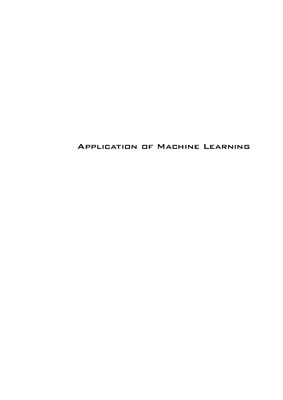Издательство InTech, 2010, -288 pp.
In recent years many successful machine leaing applications have been developed, ranging from data mining programs that lea to detect fraudulent credit card transactions, to information filtering systems that lea user’s reading preferences, to autonomous vehicles that lea to drive on public highways. At the same time, machine leaing techniques such as rule induction, neural networks, genetic leaing, case-based reasoning, and analytic leaing have been widely applied to real-world problems. Machine Leaing employs leaing methods which explore relationships in sample data to lea and infer solutions. Leaing from data is a hard problem. It is the process of constructing a model from data. In the problem of patte analysis, leaing methods are used to find pattes in data. In the classification, one seeks to predict the value of a special feature in the data as a function of the remaining ones. A good model is one that can effectively be used to gain insights and make predictions within a given domain.
General speaking, the machine leaing techniques that we adopt should have certain properties for it to be efficient, for example, computational efficiency, robustness and statistical stability. Computational efficiency restricts the class of algorithms to those which can scale with the size of the input. As the size of the input increases, the computational resources required by the algorithm and the time it takes to provide an output should scale in polynomial proportion. In most cases, the data that is presented to the leaing algorithm may contain noise. So the patte may not be exact, but statistical. A robust algorithm is able to tolerate some level of noise and not affect its output too much. Statistical stability is a quality of algorithms that capture true relations of the source and not just some peculiarities of the training data. Statistically stable algorithms will correctly find pattes in unseen data from the same source, and we can also measure the accuracy of corresponding predictions.
The goal of this book is to present the latest applications of machine leaing, mainly include: speech recognition, traffic and fault classification, surface quality prediction in laser machining, network security and bioinformatics, enterprise credit risk evaluation, and so on. This book will be of interest to industrial engineers and scientists as well as academics who wish to pursue machine leaing.
The book is intended for both graduate and postgraduate students in fields such as computer science, cybeetics, system sciences, engineering, statistics, and social sciences, and as a reference for software professionals and practitioners. The wide scope of the book provides them with a good introduction to many application researches of machine leaing, and it is also the source of useful bibliographical information.
In recent years many successful machine leaing applications have been developed, ranging from data mining programs that lea to detect fraudulent credit card transactions, to information filtering systems that lea user’s reading preferences, to autonomous vehicles that lea to drive on public highways. At the same time, machine leaing techniques such as rule induction, neural networks, genetic leaing, case-based reasoning, and analytic leaing have been widely applied to real-world problems. Machine Leaing employs leaing methods which explore relationships in sample data to lea and infer solutions. Leaing from data is a hard problem. It is the process of constructing a model from data. In the problem of patte analysis, leaing methods are used to find pattes in data. In the classification, one seeks to predict the value of a special feature in the data as a function of the remaining ones. A good model is one that can effectively be used to gain insights and make predictions within a given domain.
General speaking, the machine leaing techniques that we adopt should have certain properties for it to be efficient, for example, computational efficiency, robustness and statistical stability. Computational efficiency restricts the class of algorithms to those which can scale with the size of the input. As the size of the input increases, the computational resources required by the algorithm and the time it takes to provide an output should scale in polynomial proportion. In most cases, the data that is presented to the leaing algorithm may contain noise. So the patte may not be exact, but statistical. A robust algorithm is able to tolerate some level of noise and not affect its output too much. Statistical stability is a quality of algorithms that capture true relations of the source and not just some peculiarities of the training data. Statistically stable algorithms will correctly find pattes in unseen data from the same source, and we can also measure the accuracy of corresponding predictions.
The goal of this book is to present the latest applications of machine leaing, mainly include: speech recognition, traffic and fault classification, surface quality prediction in laser machining, network security and bioinformatics, enterprise credit risk evaluation, and so on. This book will be of interest to industrial engineers and scientists as well as academics who wish to pursue machine leaing.
The book is intended for both graduate and postgraduate students in fields such as computer science, cybeetics, system sciences, engineering, statistics, and social sciences, and as a reference for software professionals and practitioners. The wide scope of the book provides them with a good introduction to many application researches of machine leaing, and it is also the source of useful bibliographical information.

